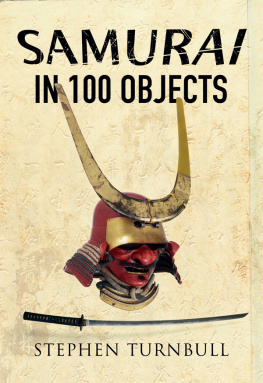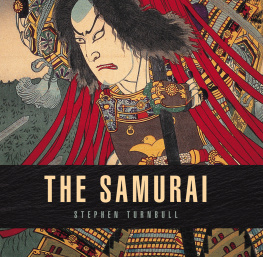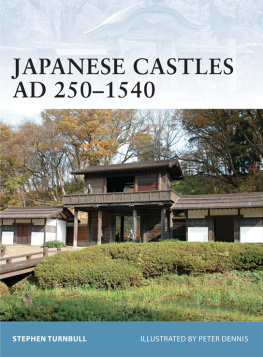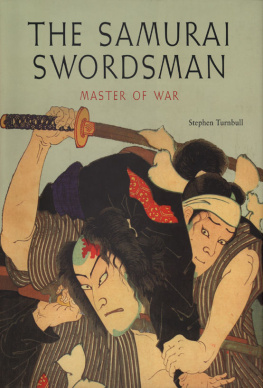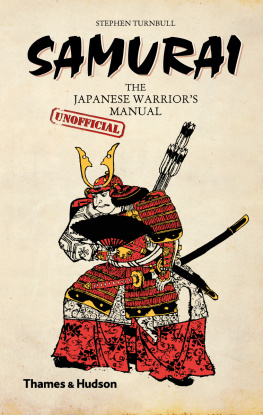Turnbull Stephen - The Samurai: A Military History
Here you can read online Turnbull Stephen - The Samurai: A Military History full text of the book (entire story) in english for free. Download pdf and epub, get meaning, cover and reviews about this ebook. publisher: Taylor & Francis Group, genre: Romance novel. Description of the work, (preface) as well as reviews are available. Best literature library LitArk.com created for fans of good reading and offers a wide selection of genres:
Romance novel
Science fiction
Adventure
Detective
Science
History
Home and family
Prose
Art
Politics
Computer
Non-fiction
Religion
Business
Children
Humor
Choose a favorite category and find really read worthwhile books. Enjoy immersion in the world of imagination, feel the emotions of the characters or learn something new for yourself, make an fascinating discovery.
- Book:The Samurai: A Military History
- Author:
- Publisher:Taylor & Francis Group
- Genre:
- Rating:3 / 5
- Favourites:Add to favourites
- Your mark:
- 60
- 1
- 2
- 3
- 4
- 5
The Samurai: A Military History: summary, description and annotation
We offer to read an annotation, description, summary or preface (depends on what the author of the book "The Samurai: A Military History" wrote himself). If you haven't found the necessary information about the book — write in the comments, we will try to find it.
The Samurai: A Military History — read online for free the complete book (whole text) full work
Below is the text of the book, divided by pages. System saving the place of the last page read, allows you to conveniently read the book "The Samurai: A Military History" online for free, without having to search again every time where you left off. Put a bookmark, and you can go to the page where you finished reading at any time.
Font size:
Interval:
Bookmark:
THE SAMURAI
A MILITARY HISTORY
Cover Illustration
The cover illustration depicts a battle between samurai of the Taira clan and warrior monks of the Kfuku-ji in Naraduring the winter of 1180/81.The section, whichshows the use of bows, swords, naginata (glaives) anda kumade (rake), is from the scroll Kasuga Gongen Genki-e (Imperial Household Collection).

Hara-kiri. A warrior commits suicide in the way that the ritual later developed, whereby a trusted friend stands by to decapitate the victim. (E.G. Heath Collection.)
The Samurai
A Military History
Stephen Turnbull

THE SAMURAI
A MILITARY HISTORY
First published 1977 by George Philip (Osprey Publishing Ltd)
First paperback edition published 1996 by
JAPAN LIBRARY
Second Impression 1999
Reprinted 2002,2005
by Routledge
2 Park Square, Milton Park, Abingdon, Oxon, OX14 4RN
Transferred to Digital Printing 2007
Routledge is an imprint of the Taylor & Francis Group
1977 & 1996 Stephen Turnbull
All rights reserved. No part of this publication may be reproduced or transmitted in any form, or by any means without prior permission in writing from the Publishers, except for the use of short extracts in criticism.
British Library Cataloguing in Publication Data
A CIP catalogue entry for this book is available from the British Library
ISBN 1-873410-38-7
Set in Bembo 12pt in Bookman, Slough
Publisher's Note
The publisher has gone to great lengths to ensure the quality of this reprint
but points out that some imperfections in the original may be apparent
For Jo, again
T wenty years ago, on completing the manuscript for this book, I began the preface with the phrase Samurai has become a familiar word. The success of this work has served to make it all the more familiar, so I am delighted that Japan Library are publishing the first paperback edition.
It is inevitable that, after twenty years and ten more books, I am able to recognize certain errors in The Samurai that were not apparent to me when I first compiled it. The present edition has enabled me to carry out a complete revision of the text, and I have been pleased to discover that such mistakes are minor ones of dates and nomenclature. Apart from these corrections, the text has required little editing, but I have taken the opportunity to remove certain unnecessary value judgements, and other comments that subsequent research has shown to be inaccurate. For example, in the first edition I described the battles of Kawanakajima as gentle jousting hardly an adequate expression for the 1561 encounter which had a casualty rate of 72% on the Uesugi side!
I have also chosen to add no new chapters to the work, as my subsequent books have done this adequately. Thus the account of the Edo Period remains as one chapter, but as this was the Age of Peace little more is required in a military history. There is also little about the samurai as patrons of the arts. In these pages the samurai is the fighting man par excellence.
As this book is about people I make no apology for the inclusion of a large number of Japanese names. To ease the task of the reader, I ignore the infuriating samurai habit of changing one's name every few years, and have referred to each individual by the name by which he is best known family name first, given name second in the old Japanese style. For example Tokugawa Ieyasu (i.e. Ieyasu of the house of Tokugawa) began life as Takechiyo and became Matsudaira Motonobu at the age of fifteen. A year later he became Matsudaira Motoyasu. When he was twenty he changed his given name to Ieyasu, and at twenty-seven discarded his family name in favour of Tokugawa. After his death he was deified as T-sh-g. We shall call him Tokugawa Ieyasu throughout.
I have also made the reading of dates simpler by converting all the lunar dates in the old chronicles, epics, and legends, to the Western calendar using Bramsen's Japanese Chronological Tables. The romanization used is the Hepburn System. All pronunciation is phonetic, the syllables beginning with a consonant. A line above V or V lengthens the vowel. To avoid tautologies, and ugly combinations of Japanese and English words, I have retained certain suffixes in names and titles, namely -gawa (river); ji (Buddhist temple or monastery); -yama (mountain or hill); and -shima (island).
In addition to the acknowledgements given under particular illustrations, I would like to mention the following individuals and institutions, whose contributions towards this work have been a great help to me:
Paul Norbury, of Japan Library; Roger Cleeve, of Osprey Publishing Ltd., for his prompt and efficient advice during the preparation of the first edition of this book; Gilbert Smith, for translations from the Japanese; K. B. Gardner, Deputy Keeper in the Department of Oriental Manuscripts and Printed Books at the British Library, for guiding me through his Department's resources, and for supplying the Japanese originals on which I based my maps; John Anderson, for allowing me to use his collection to illustrate the development of armour, and all my colleagues in the Northern Branch of the To-ken Society of Great Britain, the organization which has done so much to foster serious study of Japanese arms and armour. In particular I would like to thank my friend Ian Bottomley, whose collection has supplied several illustrations, and who put at my disposal the unpublished manuscript of his study of Japanese armour, produced in collaboration with Mr J. Hopson.
B. W. Robinson, of the Victoria and Albert Museum; H. R. Robinson of the Armouries, H.M. Tower of London; Dr Naoyoshi Ii, Mayor of Hikone; Yoshinobu Tokugawa, Director of the Tokugawa Reimeikai Foundation; Yoshimi Hayashi, Director of the Akizuki Museum, Fukuoka; Laurie Allen, of Ryde, N.S.W., Australia and Louis Allen of Durham University, have made useful contributions and offered helpful advice during the book's preparation. I. G. Clark and E. G. Heath have advised on the practical side of book publication, and Signora S. Rossi has kindly supplied me with translations from the Italian. Dr M. Tonge, my former colleague at Downing College, Cambridge, supplied me with some valuable Korean material. I would like to thank the Japan Society of London for permission to quote from their Transactions.
Once again I wish to thank my dear wife Jo, without whose constant support and encouragement none of what follows would have been possible.
Stephen Turnbull
Department of East Asian Studies
University of Leeds, November 1995
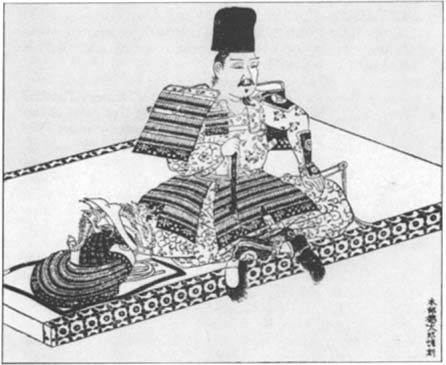
Minamoto Yoritomo (114799), the founder of the Shogunate, the hereditary military dictatorship that lasted seven hundred years. (Japan Archive)
J apan entered the modern world in 1868 in the name of a restoration of the Emperor, a shadowy figure who for centuries had been totally removed from real power by successive hegemons of a samurai class of warrior rulers. Yet there was little that was radical or revolutionary about the Meiji Restoration of 1868, at least in its early stages; for it was engineered by members of the samurai class itself and the Emperor remained what he had been since ancient times, a legitimizer of government by others. Within a decade the new samurai rulers had set Japan firmly on the course of modernization, and though they were obliged in the process to dissolve the feudal privileges of their own class, former samurai in fact became leaders in all areas of modern Japanese society. More importantly, they brought into the modern age a samurai spirit of military honour and conduct that was to remain one of the principal guidelines for behaviour in Japan until at least World War II, when Japanese soldiers lugged antique samurai swords into battle and went down before enemy fire in suicidal
Font size:
Interval:
Bookmark:
Similar books «The Samurai: A Military History»
Look at similar books to The Samurai: A Military History. We have selected literature similar in name and meaning in the hope of providing readers with more options to find new, interesting, not yet read works.
Discussion, reviews of the book The Samurai: A Military History and just readers' own opinions. Leave your comments, write what you think about the work, its meaning or the main characters. Specify what exactly you liked and what you didn't like, and why you think so.


